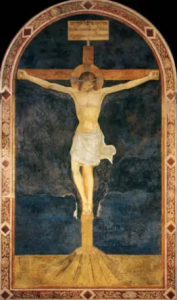In the Gospel of John, chapter 19, verses 16b-22, a pivotal moment in the narrative of Jesus’ crucifixion unfolds, rich with historical, cultural, and theological significance. The passage describes the crucifixion of Jesus and the inscription placed above his cross, a seemingly simple act that carries profound implications. This inscription, ordered by Pontius Pilate, the Roman governor, becomes a point of contention between Pilate and the Judean religious leaders, revealing layers of political maneuvering, cultural nuance, and theological depth. By expanding on this passage, we can explore the motivations behind Pilate’s actions, the significance of the multilingual inscription, and the speculative yet fascinating interpretation offered through the lens of Fra Angelico’s 15th-century painting, which suggests a hidden theological message embedded in the Hebrew text.
The passage begins with the stark statement, “There they crucified him” (John 19:18). This brief sentence encapsulates the brutal culmination of Jesus’ trial, a moment orchestrated by the convergence of Roman authority and Judean religious leadership. Pilate, as the Roman prefect of Judea, held the power to order executions, but the Gospel narrative suggests he was reluctant to condemn Jesus. Earlier in John 19:12, the Judean leaders pressured Pilate by framing Jesus’ claims as a threat to Roman authority, accusing him of claiming to be a king, which could be interpreted as treason against Caesar. Pilate, caught between maintaining order and his own reservations about Jesus’ guilt, ultimately yielded to their demands. However, the text implies that Pilate felt manipulated, and his actions regarding the inscription on the cross reflect a subtle but deliberate act of retaliation against the Judean leaders.
Pilate ordered an inscription to be placed above Jesus’ cross, a common Roman practice to declare the crime for which the condemned was executed. The inscription read, “Jesus of Nazareth, the King of the Ioudaioi” (John 19:19). The term “Ioudaioi,” traditionally translated as “the Jews,” refers to the people of Judea, particularly in this context the religious and political establishment centered around Jerusalem and the Temple. The inscription was written in three languages—Hebrew, Latin, and Greek—ensuring it could be read by the diverse population in Jerusalem, as the crucifixion site was near the city (John 19:20). Hebrew was the sacred language of the Jewish people, Latin the official language of Roman administration, and Greek the lingua franca of the eastern Mediterranean. This multilingual display underscores the public nature of the execution and the universal significance of the event.
The content of the inscription, however, provoked a strong reaction from the chief priests of the Ioudaioi. They objected, saying, “Do not write, ‘The King of the Ioudaioi,’ but rather, ‘This man said, I am King of the Ioudaioi’” (John 19:21). Their protest reveals their discomfort with the inscription’s wording, which presented Jesus’ kingship as a statement of fact rather than an accusation. By declaring Jesus “the King of the Ioudaioi,” Pilate’s inscription could be seen as affirming Jesus’ claim, potentially undermining the religious leaders’ authority and mocking their role in his condemnation. Pilate’s curt response, “What I have written I have written” (John 19:22), signals his refusal to bend to their demands, suggesting a deliberate intent to provoke or assert his authority.
To understand Pilate’s motivations, we must consider the political dynamics at play. Pilate, as a Roman official, was tasked with maintaining order in a volatile province. The Judean leaders’ manipulation of Roman law to secure Jesus’ execution placed Pilate in a difficult position. By framing Jesus as a political threat, they forced Pilate’s hand, but the Gospel suggests he recognized their accusations—particularly the charge that Jesus claimed to be the “Son of God” (John 19:7)—as a pretext rooted in religious disputes rather than genuine sedition. Pilate’s decision to inscribe “King of the Ioudaioi” can be seen as a calculated jab at the religious leaders, turning their accusation back on them. By publicly proclaiming Jesus as their king, Pilate exposed the irony of their rejection of him, while also asserting his own authority in the face of their manipulation.
The passage takes on an additional layer of intrigue when viewed through the lens of Fra Angelico’s 1434 painting of the Crucifixion, which offers a speculative interpretation of the Hebrew inscription. Fra Angelico, a Dominican friar and artist, was known for his meticulous attention to detail and his engagement with the linguistic scholarship of his time. During the early 15th century, Florence and Rome were centers of renewed interest in Hebrew, Greek, and Latin, driven by the Renaissance’s fascination with classical and biblical texts. Fra Angelico’s painting reconstructs the Hebrew inscription on the cross as ישוע הנצרי ומלך היהודים, translated as “Jesus the Nazarite and the King of the Jews.” The inclusion of the conjunction “and” (represented by the Hebrew letter ו) aligns with grammatical conventions of Hebrew, making it a plausible reconstruction of the original text.
 What makes Fra Angelico’s interpretation particularly compelling is the acrostic formed by the first letters of each word in the Hebrew inscription. Reading from right to left, the sentence is: ישוע (Yeshua), הנצרי (HaNotzri), ומלך (uMelech), היהודים (HaYehudim). The first letters—י (Yod), ה (He), ו (Vav), ה (He)—spell out יהוה (YHWH), the sacred Tetragrammaton, the covenant name of God in the Hebrew Bible. This acrostic suggests a profound theological claim: that Jesus, in his crucifixion, is identified with YHWH, the God of Israel. If Pilate’s inscription indeed contained this acrostic, it would explain the vehement objection of the chief priests.
What makes Fra Angelico’s interpretation particularly compelling is the acrostic formed by the first letters of each word in the Hebrew inscription. Reading from right to left, the sentence is: ישוע (Yeshua), הנצרי (HaNotzri), ומלך (uMelech), היהודים (HaYehudim). The first letters—י (Yod), ה (He), ו (Vav), ה (He)—spell out יהוה (YHWH), the sacred Tetragrammaton, the covenant name of God in the Hebrew Bible. This acrostic suggests a profound theological claim: that Jesus, in his crucifixion, is identified with YHWH, the God of Israel. If Pilate’s inscription indeed contained this acrostic, it would explain the vehement objection of the chief priests. For them, such a declaration would be blasphemous, as it equated Jesus with the divine name, a claim they had already condemned as heretical (John 19:7).
This interpretation, while speculative, aligns with the Gospel of John’s theological emphasis on Jesus’ divine identity. Throughout the Gospel, Jesus is presented as the Word made flesh (John 1:14), the “I Am” who shares in the divine nature (John 8:58). The acrostic YHWH in the inscription would serve as a subtle yet powerful affirmation of this theology, embedded in the very charge that led to Jesus’ death. For the chief priests, the inscription’s wording was not only politically embarrassing but also theologically offensive, as it suggested that the man they had condemned was divine.
Pilate, of course, may not have intended such a sophisticated theological statement. As a Roman official, he was unlikely to be versed in Hebrew acrostics or Jewish theology. However, his choice of wording—whether intentional or providential—carried a sting. By proclaiming Jesus as “King of the Ioudaioi,” he mocked the religious leaders’ rejection of their own messianic hopes, while the Hebrew text, as reconstructed by Fra Angelico, may have inadvertently (or divinely) pointed to a deeper truth. The multilingual nature of the inscription ensured that this message reached a broad audience, from the Jewish pilgrims reading the Hebrew to the Roman soldiers reading the Latin and the Hellenistic Jews and Gentiles reading the Greek.
The passage, therefore, operates on multiple levels. Historically, it reflects the tense interplay between Roman and Judean authorities, with Pilate using the inscription to assert his control and retaliate against the religious leaders’ manipulation. Theologically, it underscores the irony of Jesus’ crucifixion: the one condemned as a criminal is proclaimed king, and, through the lens of Fra Angelico’s interpretation, identified with the divine name. Culturally, the trilingual inscription highlights the universal significance of Jesus’ death, a message intended for all peoples.
In conclusion, John 19:16b-22 captures a moment of profound irony and complexity. Pilate’s inscription, meant to declare Jesus’ crime, becomes a proclamation of his identity, both as king and, potentially, as God. Fra Angelico’s artistic reconstruction invites us to consider the possibility of a hidden theological message in the Hebrew text, one that would have enraged the religious leaders and resonated with the Gospel’s Christology. This passage, though brief, encapsulates the political, cultural, and spiritual dynamics of the crucifixion, inviting readers to reflect on the paradox of a crucified king whose death reveals the divine.






SUPPORT AND GIVE
May the Lord bless you and keep you!
COUNT ME IN